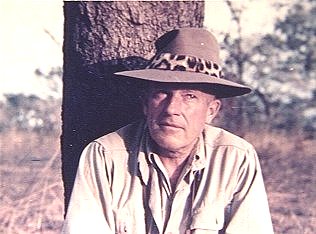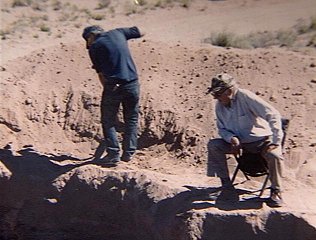

Frank C. Hibben
Frank C. Hibben, archaeologist, anthropologist, author,
outdoor adventurer, big-game hunter, philanthropist and friend to many, died peacefully in
his sleep on Tuesday, June 11, 2002 at his home in Albuquerque, New Mexico.
1910-2002
Born on December 5, 1910 in Lakewood, Ohio, Dr. Hibben was the son of Fredrick Martin Hibben and
Lucy West Hibben. Of Scottish decent, Hibben's ancestors first settled in America in the late
1600s and later in the area of Mount Pleasant, South Carolina. The"Hibben House" (1755) still
stands at 111 Hibben Street, the oldest on the Mount Pleasant side of the Charleston peninsula.
The Hibben Presbyterian Church of Mount Pleasant holds regular services to this day.
Frank Hibben first came to New Mexico in the mid-1930s on an expedition to collect small mammals
and birds for the Cleveland Museum of Natural History. A 1933 Princeton University archaeology
graduate, Hibben was so fascinated by the Native American cliff dwellings that he decided to
attend graduate school at the University of New Mexico and make New Mexico his
home. Dr. Hibben received a master's degree in zoology with field studies of the mountain lion
from the University of New Mexico in 1936. He continued his education at Harvard, receiving his
Ph.D. in archaeology in just one year, and then returned to New Mexico to begin his teaching
career at UNM.
During World War II, Hibben served in the Navy as a commissioned officer and aide to Admiral
Foy of the Joint Chiefs of Staff in Washington, D.C. His duties were to memorize final battle
plans and carry them--only in his mind--to commanding officers in the various war theaters.
He was in a plane shot down toward the end of the war by a German submarine, and carried shrapnel
until his death.
Following the war, Hibben devoted much of his time creating a museum of anthropology at UNM. He
persuaded a friend, Gil Maxwell, who had discovered the San Juan oil
field in northwestern New Mexico, to donate 50,000 shares of Occidental Petroleum stock, along
with a collection of Navajo rugs, to the University. This was the
beginning of the University's Maxwell Museum, of which Hibben served as director from 1961 to
1971.
Beginning in 1946, Hibben made a number of trips to Africa for archaeological field work.
He worked with Louis and Mary Leakey in their excavations in northern Kenya. He undertook secret
State Department missions at the behest of his friend, President Richard Nixon, who offered to
name him undersecretary for African affairs in the 1970s.
Hibben was also a world renowned big-game hunter, setting many world records. He received the
Weatherby Hunting and
Conservation Award in 1964. As chairman of the
Albuquerque Zoological Board (1960-1970), director of the Albuquerque Zoo (1977) and chairman of
the New Mexico State Game and Fish Commission (1961-1971), Hibben was instrumental in introducing
numerous exotic species to the wilds of New Mexico.
Granted full-professor status at UNM in 1952,
Hibben continued his lifelong love of teaching and, until recently, kept office hours and lectured.
At the time of his death, Dr. Hibben held the title of
Professor Emeritus. In 1994, the University honored Hibben with the Zimmerman Award, which is
given to an alumnus who has"made a significant contribution to the world and has brought fame
and honor to the University and state."
Hibben was predeceased by his wife, Eleanor "Brownie"
Hibben; his son, Patrick Hibben; and his two brothers. He is survived by his wife, Marilyn; his
lifelong friend and helper, Nora Chino Wilson of Acoma Pueblo; and his
stepchildren.
Hibben's writings were first published in 1936. Over the ensuing decades, he
authored hundreds of articles and numerous books dealing with the anthropology and archaeology
of Europe, Africa, the United States and the American Southwest and on big-game hunting. Some of
his books include The Lost Americans (1946), Treasure in the Dust (1951), Prehistoric Man in
Europe (1958), Digging Up America (1960), Hunting in Africa (1962),
Kiva Art of the Anasazi (1975) and a series of limited editions including the most recent Under
the African Sun (1999). His articles appeared in the Saturday Evening Post, Reader's Digest,
Field and Stream, Outdoor Life, the Denver Post, Empire and many sporting magazines and
professional periodicals.
In 1996, he and his late wife, Eleanor (Brownie), gifted the University with the deed to their
residence to be used as the future site of the Hibben Research Center. The house was not
practical for office and laboratory space, so Frank decided to build a new structure for the
University, from the ground up. Hibben developed the plans for
the 35,000 square foot Hibben Center at UNM and supplied
the funding for the three-story complex nearing completion (scheduled for June 2002)
on the western edge of the campus next to the Maxwell Museum. The Hibben Center will be devoted
to archaeological study and graduate research and will house collections Hibben discovered during
the excavations of Pottery Mound. The Center will also be the home of the Hibben Trust, a
$10 million endowment which
will furnish annual grants to students working in the field of archaeological research.
Services for Frank Hibben were Monday, June 17, 3:00 p.m. at the First Presbyterian Church,
in Albuquerque.
Memorial gifts can be made to UNM for the Hibben Trust for scholarships,
c/o The University of New Mexico Foundation, Inc., 700 Lomas NE, Suite 200, Albuquerque,
New Mexico 87131.
